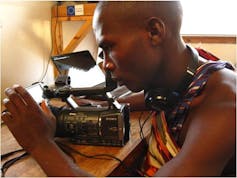My study of interaction between tourists and a Maasai community raised questions about the boundaries between research, tourism and entertainment. For one thing, the local Maasai generally classify overseas visitors, whether researchers, NGO workers, businessmen or tourists, in the same category. I also found that cross-cultural interactions don’t always help to break down stereotypes.
The study was part of a year of fieldwork with Maasai engaged in a small, locally owned ecotourism project in Northern Tanzania. The project provides camel safaris for tourists.
The mainly European and American tourists also visit a Maasai homestead as part of the safari. Because tourists are scarce in this area and it is difficult to provide advance notice of a visit, local people are normally caught by surprise when a group of visitors walks into their village. The tourists typically stay for 20 minutes to an hour, looking at the cattle corral and at people’s houses.
My research provides a detailed description of “Maasai” and “tourist” views of each other, and how these views are influenced as a result of their encounters. It shows how and why ideas about “the other” persist even if they do not match people’s experiences.
The conclusions of my research led me to direct a short film – “Eliamani’s Homestead”. The film illustrates some of my most important findings on host-guest encounters. Viewers follow the experience of a group of Dutch tourists visiting a young mother, Eliamani, and her family. Four languages – Maa, Swahili, Dutch and English – are spoken, and all conversations are subtitled.

Paolo Ngulupa, research assistant who cooperated with the transcription and translation processes.
Vanessa Wijngaarden, Author provided
Parallel fears
Why do these encounters happen, anyway? Tourists say they visit Maasailand because they are interested in cultural difference. The Kenyan and Tanzanian Maasai primarily engage in tourism as a result of the economic difference between them and the visitors, and they supplement their income by selling safaris and artefacts.
Their incentives and their fears when interacting are intimately connected and there are some striking parallels.
The Maasai and tourists fear being viewed as naive or ignorant by the other party. They fear being exploited. Both sides exaggerate the profit the other makes in the encounter. Maasai overestimate how much money tourists could make from taking photographs. Tourists blow out of proportion the value their money has in Maasailand.
Both sides fear that the other is acting purely out of narrow self-interest. Tourists worry that Maasai engage with them only to sell beads and Maasai worry that tourists’ only desire is to take pictures. Each side wonders if the other’s apparent friendliness is fake.
Tourists fear being walking wallets, but both sides worry about being cheated.
The details of the discussions about prices and payments show that the couple of Euros involved in purchasing artefacts are not the cause of the emotional outbursts of the tourists, instead it is fear of loss of face. In the same way, Maasai fear the tourists may be interested only in their cultural otherness, and consider them not as people, but as a spectacle. A clear example is when Eliamani runs behind the house to flee from the tourist camera’s gaze, because she fears the visitors are ridiculing her.
Eliamani escapes the camera.
Confronting gaze
So it is not all about material interests and exploitation. Both sides are concerned about how they are perceived. They are not so much acting on the image they have of “the other”, but reacting to the image they think “the other” has of them.
In psychology it has long been observed that “the presumed image the other has of me” is of great importance in interactions between people of different cultures. In this context, psychologists Claude Steele and Joshua Aronson described the phenomenon of the “stereotype threat”. This proved to be widely relevant, not only in relation to stereotypes about minorities but also to those about powerful majorities.
Sociologist Marie-Françoise Lanfant explains that in the tourism context, the receiving society comes to reflect upon its own traditions and values through the confrontation with otherness signified by the presence of tourists. The same is true for the tourists under the gaze of their hosts.
People are able to imagine themselves in others’ shoes and create an image of how they may be seen.
Fifteen minutes into the documentary Eliamani suddenly turns around to look straight at the filmmaker’s camera and complains about being filmed too much. And thus the filmmaker and the viewer are urged to reflect if they have become part of the problem of the voyeuristic invasion of cultural tourism.
My research, and the film raise questions whether watching a documentary or doing research are different from entertainment or tourism. And what does that mean for our identity as tourism researchers?
>>> Read full article>>>
Copyright for syndicated content belongs to the linked Source : The Conversation – https://theconversation.com/a-close-up-look-at-what-happens-when-tourists-and-maasai-communities-meet-84095































